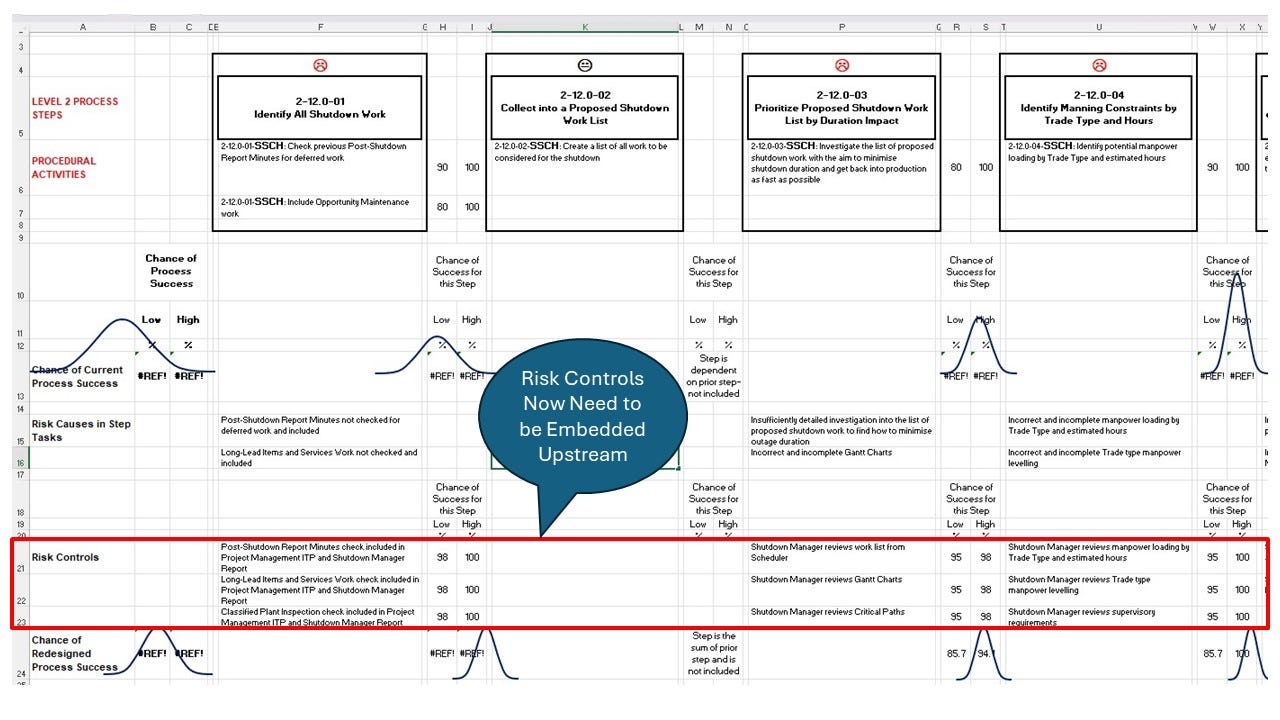Step 6 of 7: Save Your Planners from Risk of Failure with Foresight, Not Hindsight
Eliminate the risks in maintenance planning by proactively making the planning system and processes prevent risks with work packs so problems don't arise on the job
The many risks you spot when doing Step 5, Chance of Success Mapping, need to be prevented from happening. In this step, Step 6, you identify effective ways to eliminate each risk or greatly reduce its possibility of occurrence. The new risk prevention solutions are then permanently embedded into your organization’s systems, processes, procedures, practices, and culture.
Stop risks by preventing the causes that start the risks
Knowing the job planning process risks and their location from Step 5, you identify what to do to prevent each risk and where in the planning system to place each risk control. In the partial spreadsheet below, extracted from the downloadable sample Chance of Success Map provided in Step 5, the risk controls for each risk identified in a process step are recorded. Those risk controls or risk preventions measures are then incorporated into the maintenance planners’ job planning process. When that is done the Planners will be far more successful at building excellent maintenance work packs.
Gauge the new Chance of Success for the improved process
Any new risk controls added into a process step will improve that step’s chance of success, i.e. of it being done error-free. As each step is made more successful, the likelihood of successfully completing the entire process and procedure also rises. The amount of improvement in the process’ change of success expected from new risk eliminating tasks and activities can be gauged with a Chance of Success Map, as done in Step 5. Once the new success estimates for all steps are finalized you calculate the cumulative success rate improvement for the whole process. The expected success increase with the new risk controls is judged by a subject matter expert, which in the case of the maintenance job planning process, is a competent, well experienced maintenance planner.
There are three standard approaches used in PWWEAM methodology to eliminate, prevent, or reduce risks in process steps.
1. Set ACE 3T QA/QC standards that stop the causes of risks
A way to greatly improve the success rate of doing a job is to set work quality requirements for the tasks and activities needed to do the job right first time. The PWWEAM methodology uses the Accuracy Controlled Enterprise Target-Tolerance-Test technique, shortened to ACE 3T, to add quality assurance and quality controls (QA/QC) into job critical tasks—those are the tasks that must be done 100% right for the job to be properly completed.
2. Set KPI’s and PI’s to measure to prove there are no risks or causes of risks
Performance Indicators (PI’s) and Key Performance Indicators (KPI’s) are included along the process to confirm proper completion of the work up to that point in the process. Also known as ‘hold-points,’ they require the work meets one or more performance parameters that confirm prior tasks were properly done without mistakes, traps, or faults left behind to cause future problems. Work that is not to minimum performance is redone until all specified requirements are achieved.
With PI’s and KPI’s added into process steps you start collecting real-time data on the process behaviors. The historical data is charted and trended to highlight issues in the process. Data from one process can be cross-referenced to data from interacting processes to find both negative and positive effects arising between processes.
3. Be proactive and holistic—move risk prevention and risk elimination upstream and across processes
If you find you must go into external processes that impact maintenance job planning success—such as Operations, Procurement, Warehousing—to eliminate the chance that risks in those processes will cause failure of the maintenance work order planning process, then the external processes will also need to be changed to eliminate those risks.
In the next newsletter: Step 7, the final step—optimize your process for utmost productivity and successes
The next newsletter will overview the last step, Step 7. You’ll learn to find new ways to continually optimize a process by questioning and challenging each process step. Step 7 gives you the means to find new solutions and techniques to make any process more successful.
For in-depth information on building highly successful maintenance processes and procedures with the PWWEAM methodology get the Industrial and Manufacturing Wellness book from publisher, Industrial Press.
Invite others who you interact with at work to become a PWWEAM Substack subscriber so everyone can help create the utmost successful maintenance processes and procedures. Each week they’ll get insights to build success-bringing systems and processes with PWWEAM methodology.
Contact me if you have any questions on the above content.





